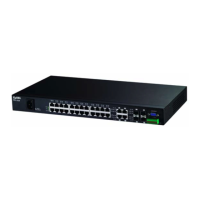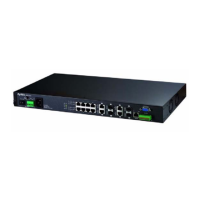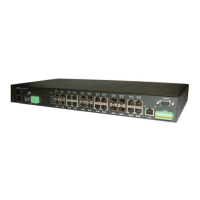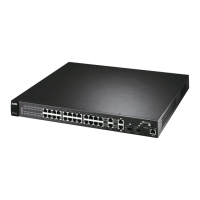Chapter 29 port Commands
Management Switch Card User’s Guide
829
This command configures impulse noise monitoring on the specified VDSL subscriber port(s).
The following example sets port 5 on the VDSL card in slot 4 to use an upstream cluster
continuation parameter of 32.
29.41.8 port vdsl inpmin Command
Syntax:
port vdsl inpmin <slot-port> <us-inp> <ds-inp>
<eim>
Set how to compute the “equivalent INP” (Impulse Noise Protection). ITU-T G.993.2
Amendment 2 and G.997.1 call this parameter INM_INPEQ_MODE.
0: the equivalent INP equals the Impulse Noise Cluster Length (INCL) with the
cluster continuation parameter set to 0. INCL is defined as the number of data
symbols from the first to the last severely degraded data symbol in the cluster. The
cluster cannot contain any gaps so this is the number of severely degraded data
symbols in the cluster. Your cluster continuation paramter configuration is ignored
when you select mode 0.
1: the equivalent INP equals the INCL with the cluster continuation parameter set
as configured. The cluster can contain gaps up to the size of the cluster
continuation parameter.
2: the equivalent INP equals the number of severely degraded data symbols in the
cluster with the cluster continuation parameter set as configured. The cluster can
contain gaps up to the size of the cluster continuation parameter.
3: the equivalent INP is set using a set of equations related to interoperation with
Reed-Solomon coding as defined in the standard, specifically in Draft Amendment 2
to ITU-T G.993.2, Section 11.4.2.2.
<ccp>
Cluster Continuation Parameter, specify a number of DMT symbols to set how big a
gap (0~64) of non-severely degraded data symbols must be to separate a cluster.
<iato>
Specify the inter-arrival time (IAT) offset ( 3~511) to determine in which bin of the
IAT histogram the IAT is reported. The offset is measured in DMT symbols. ITU-T
G.997.1 calls this parameter Impulse Noise Monitoring Inter Arrival Time Offset
(INMIATO).
<iats>
Specify the inter-arrival time step (0~7) for the IAT anomaly generation that
determines in which bin of the inter-arrival time histogram the IAT is reported. ITU-
T G.997.1 calls this parameter Impulse Noise Monitoring Inter Arrival Time Step
(INMIATS).
<isdb>
The Indication of Severely Degraded Data (ISDD) sensitivity is a Broadcom
proprietary parameter that provides an extension to the standard to allow you to
adjust the Impulse Noise Sensor sensitivity. This is only for xtuc.
• The ISDD range is -12.8 dB to 12.7 dB in 0.1 dB steps (use -128~127).
• Use the nominal 0 dB value to use the same threshold used to declare a
degraded symbol, that is a symbol marked as erased.
• Use a positive value to indicate by how many to dB to increase the nominal
threshold. This makes the sensor less sensitive and means fewer symbols will
be considered degraded.
• Use a negative value to indicate by how many to dB to decrease the nominal
threshold. This makes the sensor more sensitive and means more symbols will
be considered degraded.
ras> port vdsl inm 4-5 xtur ccp 32
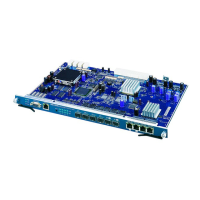
